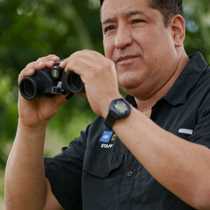Southern Isabela Island
This day found us on our way to Urbina Bay, located near Alcedo Volcano. Alcedo volcano is one of the six enormous volcanoes that form Isabela Island. This big island has a very peculiar shape, it resembles a sea horse’s silhouette. We had two walking options, the more adventurous decided to hike two and a half miles for approximately two hours on uneven and challenging terrain. Some guests opted for a shorter version. Weather conditions were ideal for the walks, it was overcast. This natural shade accompanied us during the whole morning. At one point, it rained in the form of a soft and slow drizzle known locally as “garua”. This gentle rain added a hale of mystery to the already enigmatic volcanic landscape. After the walks, a quick dip in the water was a must. Some guests participated in a water stretching session conducted by our wellness specialist.
Once everybody came back on board, our Captain commanded the National Geographic Islander’s officers to organize our departure to the next destination. On our way to Punta Moreno, an area where were we spent the rest of the day, we had a great sighting. Bottlenosed dolphins were spotted from the bridge! But the surprise was even better. A huge fish school attracted not only the dolphins but different marine bird species. Plunge diving blue-footed boobies, Galápagos shearwaters, storm petrels and pelicans were part of the feeding frenzy we observed. Suddenly, a marvelous sound was heard in the distance, the blow of a whale. Several Bryde’s whales (Balaenoptera edeni ) joined the feast. This whale species is for people who live in the northern hemisphere one of the least known members of the baleen whales (Mysticetes). They are often called “tropical whales” due to its pan tropical distribution. These huge marine mammals can reach 51 feet in length and 90,000 pounds. The whole feeding frenzy event was spectacular.
We spent the rest of the afternoon exploring the rough volcanic shoreline of southern Isabela Island. Some guests opted to hike on the irregular volcanic terrain in Punta Moreno; some opted to take a long Zodiac cruise. This ride has been one of the best we have made in this area lately. At one point we counted 126 Galápagos penguins in a single spot! Taking into consideration that the whole population of Galápagos penguins is estimated at 1,800 individuals, in a single location we observed about 7% of the whole Galápagos penguin species population. Wow! It is impossible to not feel overwhelmed by excitement with all the wonderful events that we experienced today.
This day found us on our way to Urbina Bay, located near Alcedo Volcano. Alcedo volcano is one of the six enormous volcanoes that form Isabela Island. This big island has a very peculiar shape, it resembles a sea horse’s silhouette. We had two walking options, the more adventurous decided to hike two and a half miles for approximately two hours on uneven and challenging terrain. Some guests opted for a shorter version. Weather conditions were ideal for the walks, it was overcast. This natural shade accompanied us during the whole morning. At one point, it rained in the form of a soft and slow drizzle known locally as “garua”. This gentle rain added a hale of mystery to the already enigmatic volcanic landscape. After the walks, a quick dip in the water was a must. Some guests participated in a water stretching session conducted by our wellness specialist.
Once everybody came back on board, our Captain commanded the National Geographic Islander’s officers to organize our departure to the next destination. On our way to Punta Moreno, an area where were we spent the rest of the day, we had a great sighting. Bottlenosed dolphins were spotted from the bridge! But the surprise was even better. A huge fish school attracted not only the dolphins but different marine bird species. Plunge diving blue-footed boobies, Galápagos shearwaters, storm petrels and pelicans were part of the feeding frenzy we observed. Suddenly, a marvelous sound was heard in the distance, the blow of a whale. Several Bryde’s whales (Balaenoptera edeni ) joined the feast. This whale species is for people who live in the northern hemisphere one of the least known members of the baleen whales (Mysticetes). They are often called “tropical whales” due to its pan tropical distribution. These huge marine mammals can reach 51 feet in length and 90,000 pounds. The whole feeding frenzy event was spectacular.
We spent the rest of the afternoon exploring the rough volcanic shoreline of southern Isabela Island. Some guests opted to hike on the irregular volcanic terrain in Punta Moreno; some opted to take a long Zodiac cruise. This ride has been one of the best we have made in this area lately. At one point we counted 126 Galápagos penguins in a single spot! Taking into consideration that the whole population of Galápagos penguins is estimated at 1,800 individuals, in a single location we observed about 7% of the whole Galápagos penguin species population. Wow! It is impossible to not feel overwhelmed by excitement with all the wonderful events that we experienced today.


